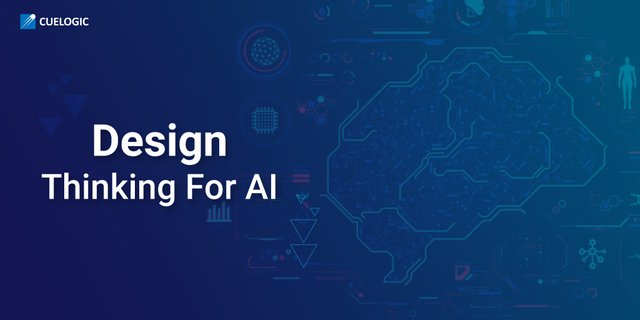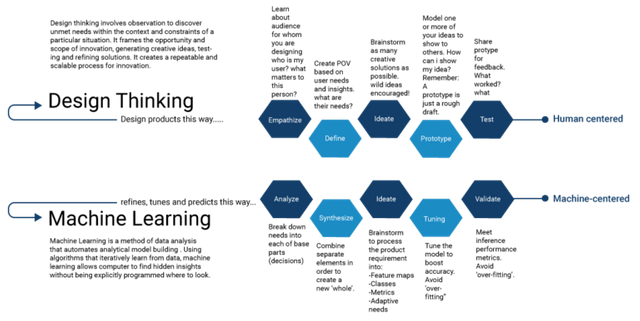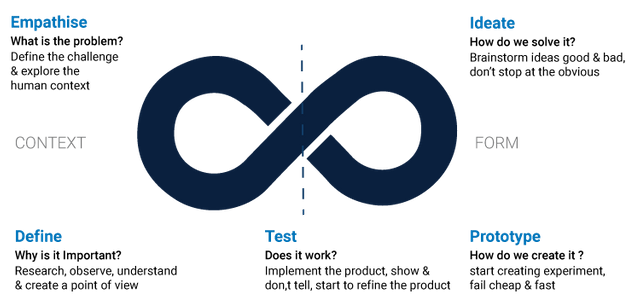
Design Thinking and AI : "Un"Complexing Automation.
It's important to approach the subject area of AI from the philosophy of design thinking. This is, so that there are a structure and an approach that is chartered out in the complex world of AI. Since there is an extensive range of solutions that one can design for AI applications, developers need to remain vigilant about the changing nature of Artificial Intelligence.
Therefore, to ensure quality and proper guidance, it’s best to think about AI from a design-thinking perspective. This captures much of the innovation that will potentially occur in the AI space so that the problem can be solved using another approach. Additionally, as AI is a rapidly evolving field, it makes the process of structuring a final proposal that much easier.
“It turns out that creativity isn't some rare gift to be enjoyed by the lucky few — it's a natural part of human thinking and behavior. In too many of us, it gets blocked. But it can be unblocked and unblocking that creative spark can have far-reaching implications for yourself, your organization, and your community." - Tom Kelley, Design Thinking & Innovation expert.
AI hasn’t been structured this way for all projects, which is why the top consulting firms and design houses are recommended across the board. It has several advantages over traditional formats of strategy, as there are operational efficiencies built in.
If we think about AI from the lens of design thinking, several ideas come out organically. We can then use AI as a tool and a platform. We don't need to restrict ourselves to thinking about technology as a sole-domain of innovation. We can go from empathizing to prototyping much faster if we leverage design thinking in AI. A reference to the process is shared below.

What is the core challenge with AI?
The essential challenge with AI is that there isn't currently a universally accepted approach when it comes to implementation. At the strategic level, some initiatives are being launched regularly, however with design thinking, and there is more structure to the approach.
There are startups and companies alike that are leveraging the capabilities of AI from a need-perspective. Mostly, they have a problem with data analytics or their logistics and want to use AI to solve it. This only covers a minute scale of the potential of AI in its full form. That’s why when adopting AI, it’s important to think about it from a design perspective.
Starting from empathizing with the consumer to finally designing a workable solution – the process is long and arduous. That's why AI needs to be structured in a way that makes real sense to everyone involved. Teams can become mobilized when there is enough attention being given to the design thinking side of the AI picture. From a resource allocation stand-point, there is greater emphasis on design thinking as it helps to optimize core processes.
“Executives who promote design thinking in their organizations can accelerate AI adoption, achieve organizational alignment and drive commitment to their goals while reducing resistance to organizational change. Design thinking practices make it possible for companies to pivot quickly when market conditions change because alignment around a core set of agile decision-making principles is already embedded in the culture of the company." - Craig Nelson, Partner ISG Research.
It all comes down to execution and how well we can deliver on our AI projects. If there are iterations necessary and problems with existing code, then we can go back into the loop to find a more scalable solution. We can also deliver on an MVP and then go back to the problem after the product is launched. When it comes to AI, data only makes it better in the long-term. AI needs a plethora of raw input to be put to good use. That’s why another challenge gets overcome when you think about AI from a design perspective.
Design thinking + AI – The future of innovation
Developers and coding teams need to think about how AI and change go hand-in-hand. From a design perspective, it is more efficient to opt for an empathy, ideate, define, test, prototype model. It is essential for companies to look at the current AI model and introduce design thinking into it. Therefore, the future of innovation is what many analysts are making it out to be – Design thinking + AI.

1. Empathize – It's important to with the problem at hand. This includes understanding the issue at a deeper level and analyzing the situation at hand. From challenges in data analytics to deep diving into informatics, various challenges and problems need to be addressed early on.
This becomes increasingly important when thinking about neural networks and how integrated AI systems will come into play. There is also an element of innovation that needs to be introduced, especially in the early stages of how well we integrate AI. That's when we need to think about the problem by empathizing with the current challenge. Only then can we gain the right insights as to how AI is going to add value to the more significant process.
2. Define – Defining the problem goes hand-in-hand with understanding the issue clearly. Are there challenges with a particular area or the holistic technology barrier? It's important to clearly state the problem in a single sentence or a paragraph. This will help align teams into making the right decisions when it comes to AI launches.
Development can also be streamlined by using the best practices of design thinking. This is because several challenges and hurdles can be crossed when companies think about AI from Design. When they define the core problem, they’re able to prepare scalable solutions at a much smoother rate. They can also move on to the next stage quicker.
3. Ideate – This is the next stage in the evolution of AI, wherein companies formulate real solutions and ideas around the problem at hand. They are also able to think about AI holistically and apply it to the problem that they're trying to tackle. This is also important from how deep learning and machine learning can be integrated into one solution line.
There can be a case where you need to use AI to process image metadata at scale. That's when you can design an AI solution to help you out. However, there may be challenges in focus and ensuring that the AI tool can allow you to scale. That's when you need to start ideating about what the actual solution could look like before you jump into the development phase.
4. Prototype – Instead of creating a full model of AI integration and launch, it’s best to create a few prototypes. These prototypes can capture the essential information necessary to process the design ahead. This can also be a working model that can demonstrate the unique capabilities at that point.
When companies move ahead with the prototype, they can design more multidimensional products that are offered under any single banner. These products are also more localized to provide solutions with within any one domain. That's where AI can add real value for the long-term.
Prototyping is the best way to protect yourself if any lapses are found during this stage. If the product is launched directly into the market without having much consideration in the prototyping phase, you may have missed out on key insights.
5. Deployment & Testing – Here is when the prototype has been proven to be successful, and there are higher chances of success to be found. The product has launched, and there is constant testing on the AI technology being implemented. It may be a simple program that is designed to make any one part of the business more efficient. However, the overall approach will be the same once deployment has concluded.
After the bugs are found and new features are requested, it’s time to go back to phase-1 wherein you will think about the problem from an empathetic perspective. This will help you prioritize your AI fixes instead of taking a shotgun approach to focus on all issues at once.
Creating an environment for successful design thinking
It’s important to get these working parts in-sync before thinking about launching your next design-thinking program.
A. Culture – You need to ensure that the culture of the development team is oriented towards design thinking.
This can be done through educational seminars, traditional learning sessions and having the entire team on one objective. Since this is a shift from the way that coding is done, it’s best to do it gradually rather than having a drastic change. It’s also essential to get upper management and leadership involved early on so that you can change the way that the culture is perceived. When the administration takes a definite stand on the new design thinking philosophy, the integration is much deeper into the culture.
“An AI revolution is underway right now, but I believe it needs to be complemented with a design revolution. We don't want to ascribe to AI algorithms more intelligence than is there. They may be smarter than humans at certain tasks, but more generally we need to make sure algorithms are designed to help us, not do an end-run around our common sense." - Jim Guszcza, Chief data scientist, Deloitte Consulting LLP.
B. Team Structure – It’s essential to have the right team structure when attempting an AI and design thinking process. The right team can have a significant impact on the way that the project performs. The team structure must be oriented to perform design thinking in the most efficient manner possible. This can be accomplished if there are champions/leaders within teams that can take the initiative and delegate effectively. Organizations need to get leaner, which means that all resources will be required to get aligned to the overall mission.
C. Management & Auditing – Management is essential when defining the right design thinking philosophy. It's critical to ensure that the process is being followed as designed and that there are no breaks in the chain. With prototyping, there shouldn't be ideating and vice-versa. Even though each process feeds into each other, with AI there is a unique format that works best in the long-run.
There may be confusion or lack of clarity in the space, which can be solved by introducing regular audits. Experts in the area believe that auditing is the best way to approach the problem of clarity. Auditing the current process is an excellent way to create more transparency in the system to find the core problem.
Application from the customer's point of view
We need to think about design from the customer’s perspective. It’s important to understand where the maximum value is if we consider the customer’s point of view as critical. Customer research and insights count for a lot when thinking about design orientation in the AI space. Design thinking is all about looking at the picture by empathizing with the end consumer.
Whether that is the B2B space or the B2C, customer opinions matter to a large degree. That’s why the design process has steps incorporated to include customer feedback and utility. Design thinking can be oriented to look at the bigger picture by thinking about the end user. If the application is unusable then what is the point of adopting the technology? The end-user will also provide vital insights about using the technology as well. These insights can be fed back into the process to refine the approach further.
Applying design thinking the right way is essential. Customer feedback and inputs early on are the key to incorporating AI with design thinking in a more refined manner. Research from SAP suggests that working directly with AI proves to be beneficial when having a customer-oriented approach. The difference in growth is as much as 43% in many cases.
Integrating Design thinking with AI (Checklist)
This is a common framework that is good to kickstart the process and almost all companies can utilize. It boils down to the basics and can be leveraged by any company that is working (or looking to work) with AI.
“Philosophy is fundamental to design thinking. It’s critical to understand your attitude and mindset before approaching a problem. Predicting heart diseases with algorithms in some cases may not be ideal, but we can encourage cardiologists to use algorithms to improve health care decision-making.” - Karthik Dinakar
1. Addressing the problem –
For a practical solution to be formed, it’s essential to solve the issue first-hand. This can be done by creating the right framework around problem capturing. When the question is captured perfectly, companies can address the problem and analyze it. They can also generate case studies around their problem areas and visualize an AI-enabled solution.
2. Examining the impact (ideation, refining, etc.) –
When companies can analyze the effect of the problem and the solution holistically, they can create a genuinely transformational prototype. Companies can then leverage the solution after examining the ecosystem holistically. They can then design the right product that can create an impact. Otherwise, the product may fail at launch as it wasn’t intended to solve the real problem.
3. Prototyping and testing –
When companies have defined the problem well, they can start to create a robust prototype. This prototype can be designed to tackle smaller issues and challenges within the domain. The actual AI being used can be leveraged across a smaller scale. Companies can then scale up and then use that prototype as a proof of concept. This way of execution is more efficient and delivers on the original promise of quality AI production.
More important than the checklist or the archetype is the implementation and the overall strategy that is being used. When companies have a design-thinking mentality, they can then deliver on their mission to create a more robust product. AI is then used as a platform on which developers can build memorable experiences.
Conclusion
Overall, it’s important to think about AI from a design perspective. There is a problem that is highlighted and a charted pathway that makes the most amount of sense for it. That’s the best approach when it comes to solving complex problems with AI. The journey from empathy to the solution is a complex one, but with design, thinking developers can accomplish the end-goal.
While the objective isn't to remain constricted to design thinking, it's a valuable approach that makes development that much more straightforward. If we think about the challenges that face us via design thinking, we can design solutions that are workable in the field. We can go from the paper and code world to the real world wherein we can develop workable solutions and models. We can prototype the perfect product and ensure that AI is working around real needs areas.
Originally Posted on Cuelogic Blog
Hi! I am a robot. I just upvoted you! I found similar content that readers might be interested in:
https://www.cuelogic.com/blog/design-thinking-for-ai
Downvoting a post can decrease pending rewards and make it less visible. Common reasons:
Submit
Congratulations @cuelogictech! You have completed the following achievement on the Steem blockchain and have been rewarded with new badge(s) :
You can view your badges on your Steem Board and compare to others on the Steem Ranking
If you no longer want to receive notifications, reply to this comment with the word
STOPVote for @Steemitboard as a witness to get one more award and increased upvotes!
Downvoting a post can decrease pending rewards and make it less visible. Common reasons:
Submit